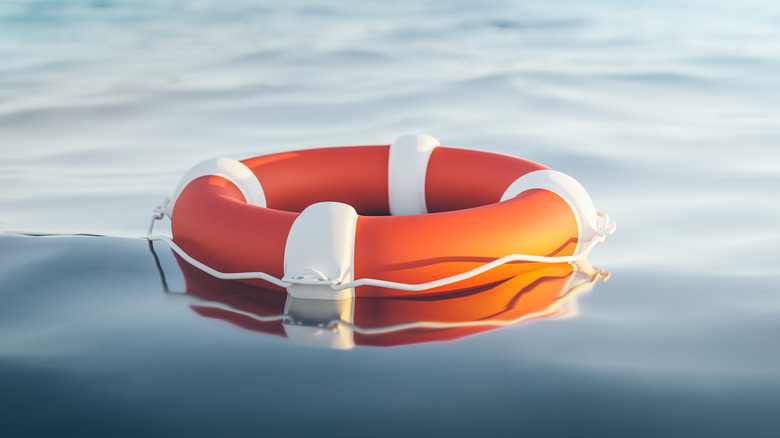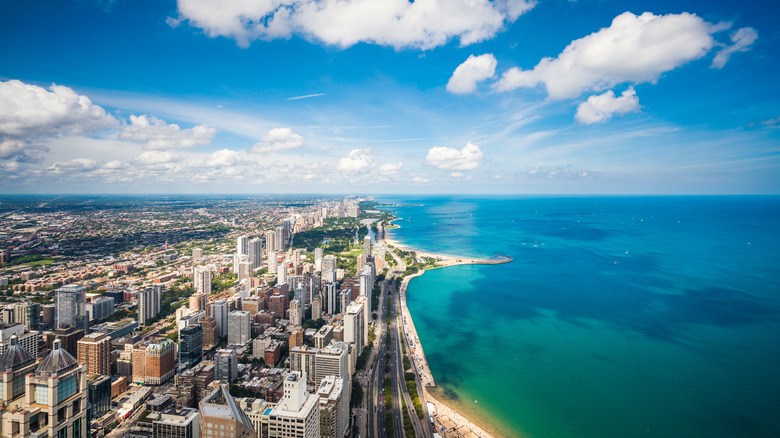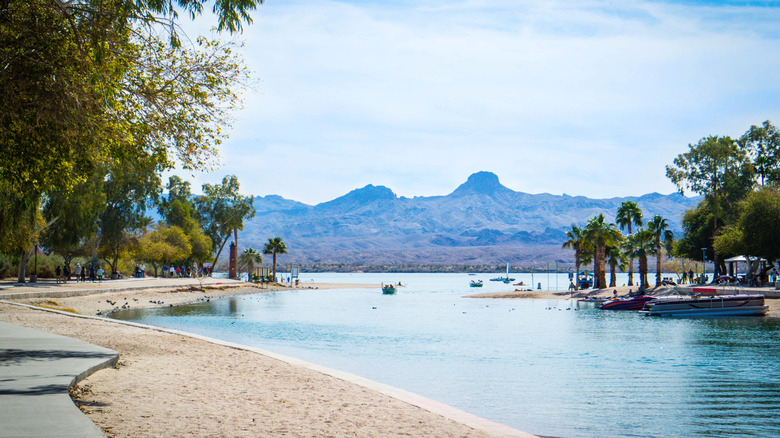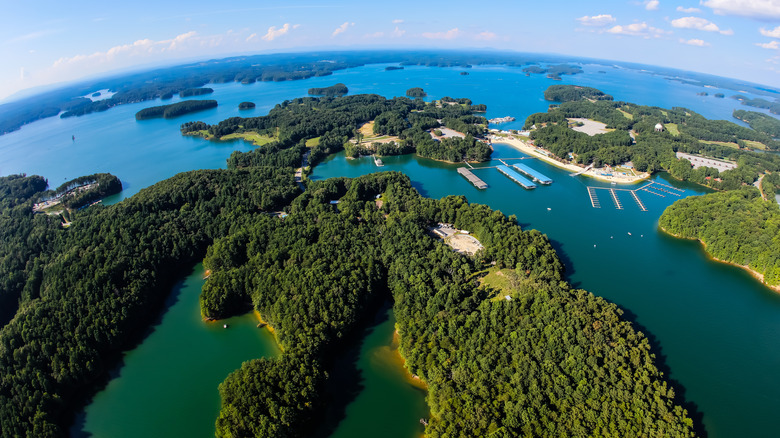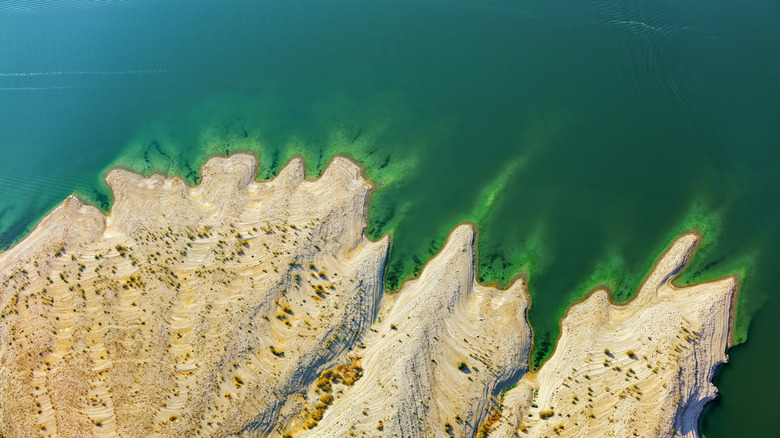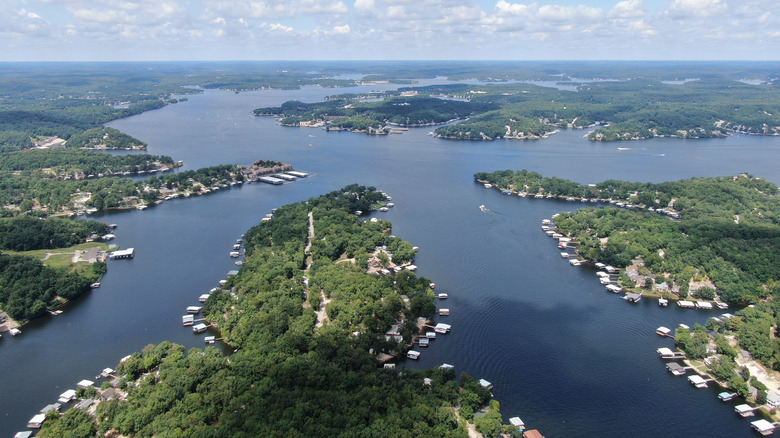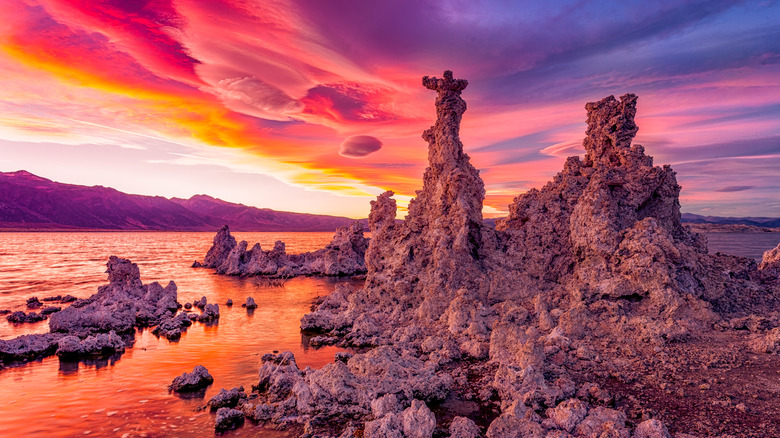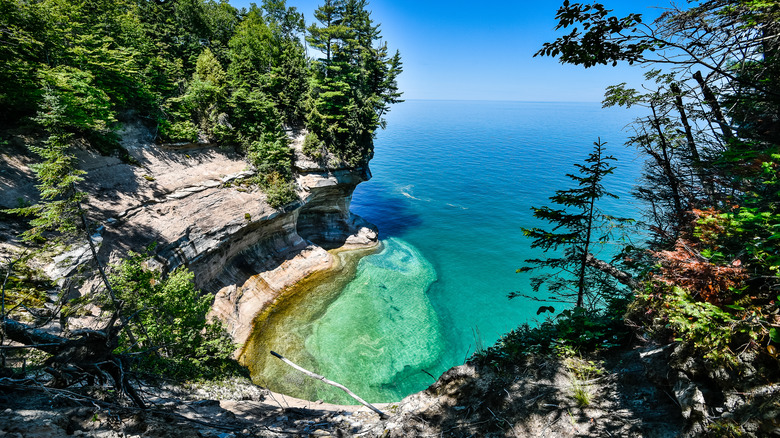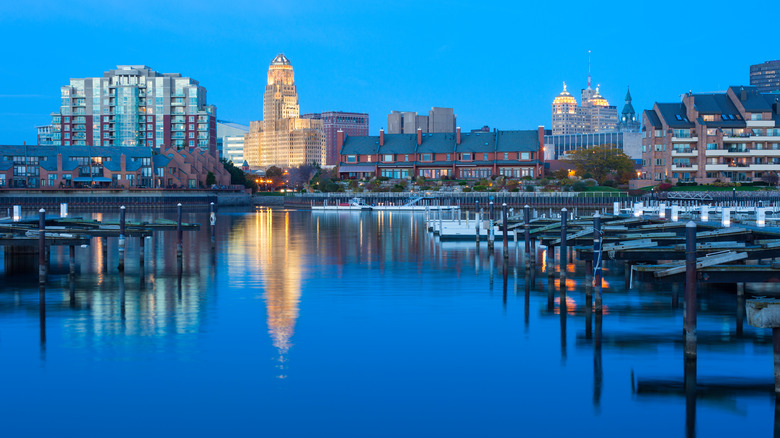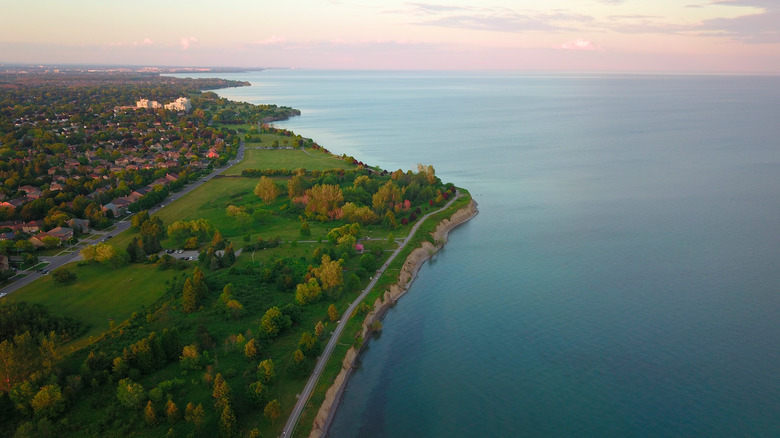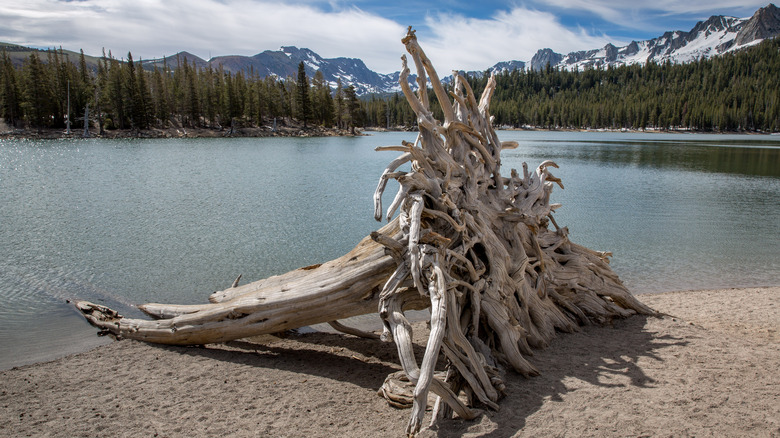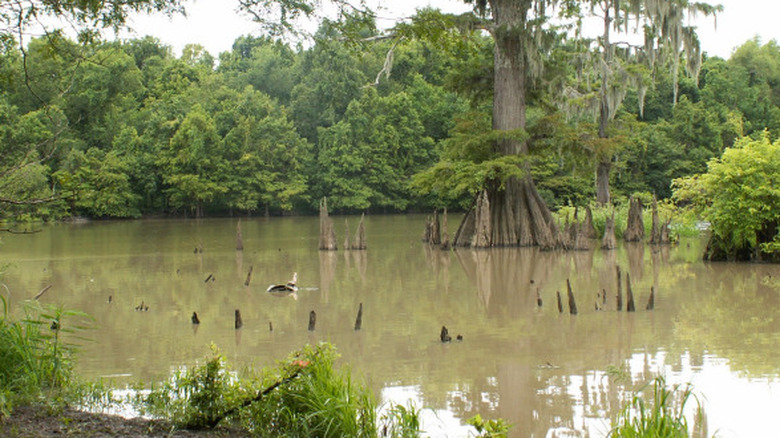You May Not Want To Swim In These Popular US Lakes
Swimming at the lake is an age-old pastime that countless Americans have engaged in throughout the years. Taking time away from your busy schedule to relax by your favorite lake can be an immensely rewarding experience for a number of reasons, and swimming in general is a fun way to improve your overall physical health and have some fun with friends at the same time.
But swimming can be dangerous, too, especially in the waters of certain lakes. The idyllic charm of the lakeside vista might cast a particular vision of these recreational areas that counters this reality, but the truth is that swimming in lakes can be particularly dangerous. Even the most experienced swimmers can succumb to the effects of cold water shock, potentially introducing a sudden drowning scare. This is a reflex action that can happen within a few seconds of jumping into cold water that involuntarily causes you to gasp for air — even if you're still under the surface. Particularly deep lakes are more dangerous than shallower waters for this reason because they are routinely much colder.
Lakes can also exhibit unpredictable tidal behavior that may drag a swimmer out past their comfort zone. Lastly, many lakes across the world contain high levels of toxins or bacteria, which can be harmful to those who decide to take a dip. Many lakes in America are perfectly safe for swimmers, but these ones can be particularly hazardous and might warrant a second thought before plunging beneath the surface.
Lake Michigan
The Great Lakes are all water bodies that swimmers should think twice about entering. Lake Michigan in particular is the roughest of the Great Lakes, and poses a major risk to those thinking of taking a dip. This body of water is often named the most dangerous lake in the United States. Ironically, it's also one of the most visually stunning of the Great Lakes and the positioning of Chicago and Milwaukee in particular ensure that huge crowds gather along its shores every spring and summer.
The trouble lying in the depths of Lake Michigan stems from its elongated, parallel shores. The lake experiences strong rip currents because of the wake formed as waves crash against the east and west edges (and then flow back into one another in the center). Rip currents have a way of sweeping unsuspecting swimmers out much farther than they can manage easily. Out here in the cold waters of the lake, swimmers can become disoriented and begin to panic. Estimates place the total number of deaths on the lake at almost 300,000, making it a tragic beauty in the natural environs of the American Midwest. If you do consider swimming in Lake Michigan, it's crucial to understand that currents can change rapidly. Fortunately, defeating this scary situation is just a matter of patience and the ability to identify your exit. Calmly assess your predicament, and then swim parallel to the shore until you are free of the water's drag.
Lake Havasu
Lake Havasu isn't a particularly dangerous water body on its own. The lake is a popular spring break destination in Arizona and sees a surge of swimmers and boaters arrive on its shores every year as the winter begins to subside. The water is a part of the Colorado River and sits in a reservoir formed by the Parker Dam. Originally, the area that now supports the lake was home to the Mojave people, and the name comes from the Mojave word for blue — which the water certainly is a lovely shade of!
The lake is a magnet for fishing enthusiasts, and almost 750,000 people attend fishing competitions here every year. But, there's another side to the lake's culture: It's a popular drinking destination for swimmers, boaters, and sunbathers. The recreational use of drugs and alcohol that has crept into the lakeside experience adds a unique strain to the well-being of people who frequent the area. There are a significant number of boating accidents that occur here every year, and many are a direct result of irresponsible drinking mixed with the operation of these vehicles. Swimmers aren't immune to this phenomenon either. Swimming while intoxicated adds a significant danger for even the most advanced water athlete.
Lake Lanier
Lake Lanier is a beautiful recreational area roughly an hour away from Atlanta. Visitors can partake in boating, tubing, kayaking, and of course swimming. Lake Lanier is Georgia's largest lake, and it supports a vibrant relaxation environment. However, there's a darker undertone to the water body that has become a trending component of any discussion surrounding the area. Lake Lanier is exceedingly dangerous for swimmers, with roughly 700 total deaths on the water.
The lake appears as a jagged crack in the Earth's surface, created as an artificial reservoir when the Buford Dam was completed. It stretches across a truly huge crevice that measures some 59 square miles. Throughout the waters, submerged logs and other debris can be found and create an unsteady floor that can cause problems for those looking to put their feet down for a break. As well, the lake exhibits a noticeable drop-off in depth, creating the potential for swirling undercurrents that make the lake unpredictable. Sudden depth also creates a chilling effect that can contribute to cold water shocks.
Lake Mead
Because Lake Mead is a national recreation area, you might not suspect that it would be named one of the most dangerous aquatic relaxation spots in America. However, the lake is infected with a blue-green algae bloom that explodes in the spring and summer. The algae itself isn't harmful to humans, but with enough algae in the water, the toxins that are created by this particular growth can become dangerous. The bloom is pushed by wind and water currents, however, and doesn't take over the entirety of the lake. This means that keeping an eye on advisories and warnings is a must if you plan to visit Lake Mead, especially at times of peak algae growth.
In addition to the growing algae in the water, the national recreation area is seemingly a hot spot for violent crime. 275 people died at Lake Mead between 2006 and 2016, and during this time there were also six homicides recorded, the most at any national park. Whatever the reasons, it's apparently crucial to remain vigilant at Lake Mead, whether you hope to swim or simply relax on the shore!
Lake of the Ozarks
Lake of the Ozarks is a fascinating aquatic destination found in the nation's geographic center. It's smack in the middle of Missouri and the twisting tendrils of water that combine to form the nearly dragon-shaped water body are the product of intentional flooding alongside construction of the Bagnell Dam, which was completed in 1931. It's one of the largest human-created lakes in the world and supports a thriving holiday-making economy. It's a famous lake that averages roughly 5.4 million visitors every year (over 10 million in 2020 alone).
However, the Lake of the Ozarks is not without its hazards. Many say that the lake is haunted by restless spirits, but in a more concrete way, the lake is riddled with unexpected depth changes, underwater caves, and surprisingly strong currents that can turn without warning. All of these features make swimming in the waters of this lake a risky proposition. To make matters worse, however, the lake is often frequented by those on holiday who may be drawn to drinking while enjoying the scenic coastline. Boating accidents spurred on by intoxicated operators, and swimmers who find themselves suddenly overwhelmed by the water's force after having a few too many, are sadly common occurrences here. Taking additional precautions if you plan to dive in for a soak is therefore an important step for safe swimming in the Lake of the Ozarks.
Mono Lake
An inland, saline water body in California, Mono Lake is not connected to any external aquifers, river features, or other waters in its surrounding area. As a result, Mono Lake supports no ability to regulate the contents of its liquid. The combination of volcanic ash and a lack of outflowing water movement means that evaporation leaves behind salts and other minerals that continue to increase over time in the lake's remaining water chemistry. Today, Mono Lake is saltier than the ocean and has a pH level of around 10, roughly similar to a household glass cleaning solution, like Windex!
One chemical that has become increasingly prevalent in Mono Lake is arsenic, making the lake not only unswimmable but also uninhabitable for all but the most extreme of species. Scientists have found just three varieties of "extremophiles" in the lake: a microscopic nematode, a brine shrimp, and a diving fly. The lake's geological limestone structures that tower up from the surface make it a distinctive sight to behold, but swimming in the lake is simply not an activity that you should consider.
Lake Superior
Lake Superior is another scenic water body found in the high northern reach of America's Midwest. Michigan's Upper Peninsula, Wisconsin, and Minnesota all border Lake Superior, as well as Ontario to the north. Therefore as you might expect, Lake Superior is extremely cold. As Visit Duluth points out, it's one of the world's largest freshwater lakes, clocking in an area about the size of Austria. "It is also the coldest and deepest of the Great Lakes, with a maximum depth of 406 meters (1,332 feet)," according to the State of Michigan. This drastic decline makes for a seriously cold chill that can shock even the most experienced swimmers and routine cold water bathers. Researchers note that the involuntary gasp associated with cold shock response isn't the only threat in excessively cold water. In addition to this reflex, very cold water can rapidly induce an increase in heart rate to a level more akin to sprinting or other heavy exercise. Combined with the environment, this can cause a swimmer to hyperventilate and create an additional level of risk.
However, the cold is only one aspect of Lake Superior's hazards. The weather on the lake can turn at a moment's notice, creating significant swell and threatening boaters and swimmers alike. The lake also combines a dense commercial shipping lane with heavy fog conditions that often roll across its surface. This creates visibility problems and additional hazards both far out into the waters and along the shore.
Lake Erie
Another one of the Great Lakes, Lake Erie poses a number of potentially harmful issues to the average swimmer. As NASA Earth explains, "The name Lake Erie is believed to have originated as a shortened version of erielhonan — a word meaning 'long-tailed cat' in the language of the Iroquois tribe that once lived along the lake's southern shores. The name was likely a reference to the fickle, unpredictable, and sometimes violent behavior of the eastern cougar. Those characteristics are shared by the lake."
The name is especially apt considering the enormous volume of shipwrecks that can be found beneath its surf. The lake also experiences a significant algae bloom that returns on a seasonal basis every year. The algae is a product of localized agricultural and industrial runoff from communities bordering on its waters. This algae can contribute to increased health concerns for swimmers who spend a good deal of time in the lake.
Multiple drownings also occur in Lake Erie every year as a result of its finicky tides and sudden shifts in wave period, strength, and height. These features come as a result of the lake's uneven bed beneath the waters as well as weather patterns up above the surface, which can whip up a frenzy in the lake's wave pattern. Strong currents, resurgent algae presence, and a demanding nautical surface for boaters combine to create a dangerous space for swimming.
Lake Ontario
Along with Lake Erie, Lake Ontario is the most polluted of the Great Lakes. This contributes to potential health risks associated with bathing in its waters, an issue that the other three Great Lakes do not add to the mix. Over the summer of 2023, three beaches on the Canadian side of Lake Ontario were regarded unsafe for swimming as a result of high levels of E. coli. Remaining vigilant and on the lookout for bacteria and other pollutants is an important piece of safety when thinking about any water body to swim in.
Lake Ontario also brings about the risk of cold water shock and hypothermia because of its location in the far northern latitudes of the United States. Experts estimate that even strong swimmers are likely to face risks if exposed to the lake's cold depths for as little as an hour — and likely shorter for most who might find themselves dragged out in the current or falling overboard on a boat trip. Furthermore, waves can reach around 10 feet in height during times of particularly rough weather, creating the perfect conditions to suck kayakers, boaters, and swimmers far away from the lake's shores.
Horseshoe Lake (California)
Horseshoe Lake in California poses a different kind of threat than most of the other water bodies on this list. Instead of offering up potentially deadly currents or cold water concerns, Horseshoe Lake is afflicted with high concentrations of carbon dioxide. The U.S. Forest Service notes, "It is believed that earthquake and magmatic activity beneath the area in 1989 opened channels for the gas to reach the surface." The high density of CO2 is responsible for killing off around 120 acres of trees around the lake and mountain area, and the gas itself was first detected by scientists in 1994.
You are able to visit the area, but extreme caution should be observed throughout your stay around Mammoth Mountain and Horseshoe Lake beneath it. People have died long after the explanation for this phenomenon at the lake was discovered, highlighting the severe risks associated with both carbon dioxide gas and this grim tourist draw.
Devil's Swamp Lake
Finally, Devil's Swamp Lake is a fitting end to a list of dangerous lakes that you might want to shy away from. The name perfectly suits the lake's imbued traits, as this is the most toxic lake in the state of Louisiana. The EPA added it to its Superfund list in 2004 — a designation signaling the public health hazards of the site and a mandate to address the issue. Numerous plans to rectify the toxins embedded within the lake's waters have come down the pike in the years since, but Devil's Swamp Lake remains a substantial hazard to the people who live nearby. Visitors shouldn't even touch the water because it contains high levels of mercury, lead, and other cancer-causing chemical substances.
The lake sits around 10 miles north of Baton Rouge and was established as a result of the construction of Baton Rouge Harbor in 1973. It's an oxbow lake that spans a swampy environment. Alarmingly, around 1,600 people live within a two-mile radius of the toxic water body. The alarm comes from years of industrial waste, specifically runoff from Rollins Environmental Services, a hazardous waste site that opened in 1971.
